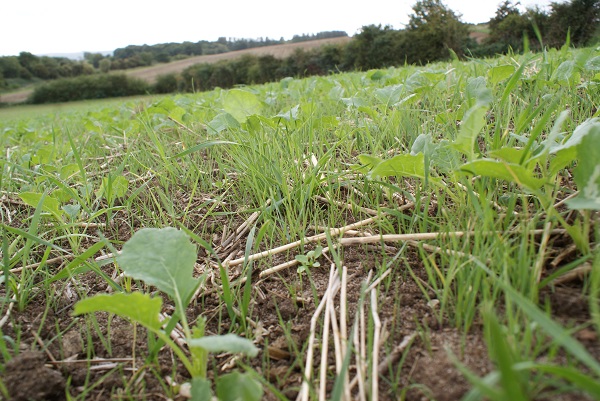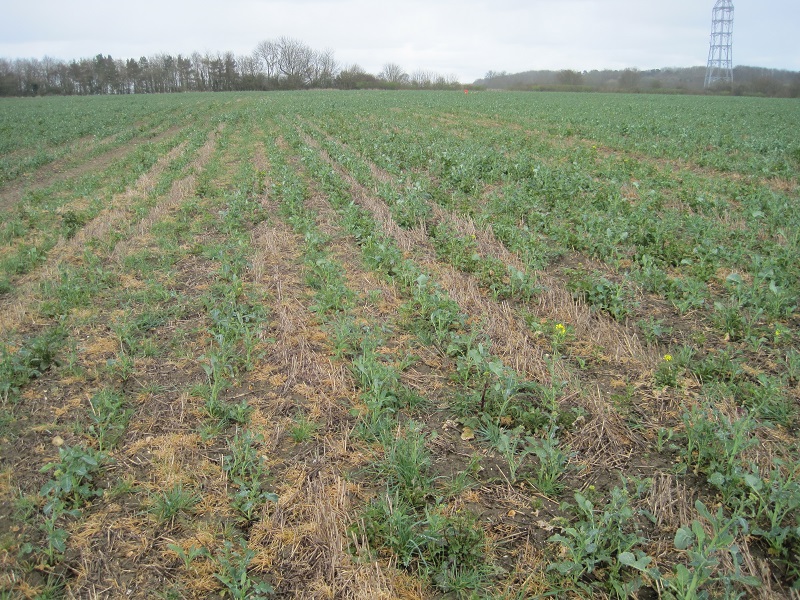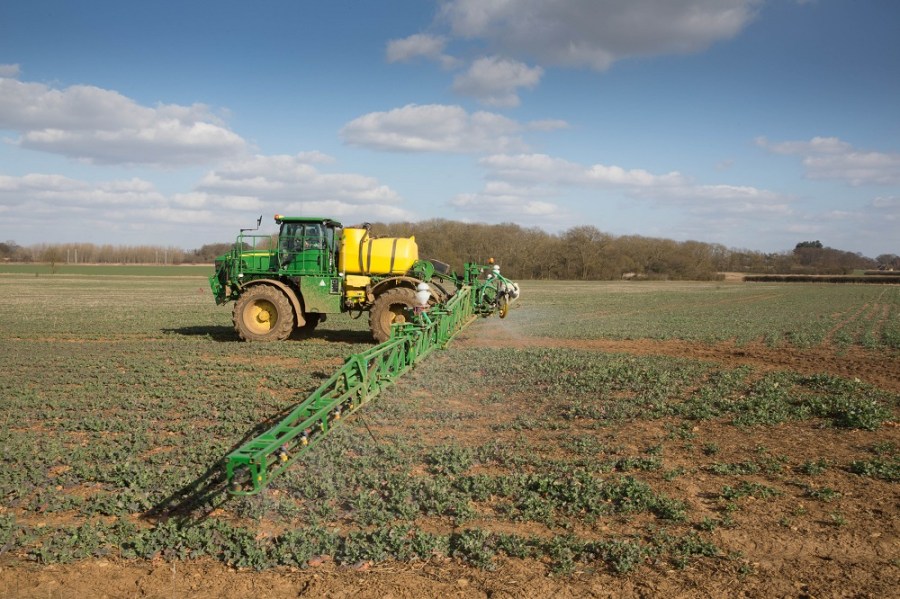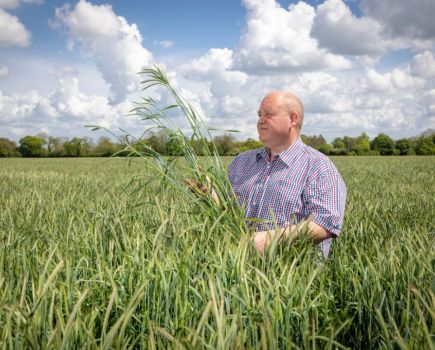Weed control in oilseed rape was a hit-and-miss affair for many last season. CPM finds out how the new crop is faring and the prospects for keeping it clean.
OSR shouldn’t be the weak link in the rotation as far as weed control goes.
By Lucy de la Pasture
Oilseed rape crops have got off to a bumpy start in some areas of the country. A dry Aug was a blessing for the wheat harvest but didn’t greatly help OSR that was drilled very early, explains Procam agronomist, Tom Scotson.
“Some growers got their OSR in but it didn’t germinate because of the lack of soil moisture. The east coast and parts of Kent were particularly badly affected,” he explains. “Although these have now come through after some Sept rainfall, they’re very small so equivalent to a late drilled crop even though they’ve been in the ground for longer than most.”

Oilseed rape provides an ideal opportunity for some alternative modes of action in the rotation to tackle blackgrass problems.
Some growers have already given up on some fields, especially where cabbage stem flea beetle activity is providing a double-whammy effect, he reports. A small OSR plant makes for a slow-growing crop, which at this stage in the day is one that needs careful consideration.
Ground Cover
“Plants need to have made good ground cover by mid-Oct, otherwise pigeon grazing can become a big battle until the spring. Deciding whether or not to stick with the crop or cut your losses and get something else in the ground is a very personal decision. It’s not black and white but either way, herbicide inputs will need to be considered, whether sticking with the crop or ripping it up,” he says.
Not long ago, the standard approach to the OSR herbicide programme was to apply a pre or early-post emergence product. In recent seasons, uncertainties about crop establishment have led to a total change in strategy, with many growers now adopting a wait-and-see attitude before spending money on herbicides at a stage when survival of the crop is far from certain.
In situations where the crop fails and metazachlor has been applied, it’s really important to consult the label of the metazachlor product used, because restrictions on re-planting following crop failure vary widely between products, warns Paul Cartwright of Frontier.

Even as weed growth slows with decreasing temperatures, weeds continue to take up propyzamide through their roots, it just takes longer to reach a lethal dose.
“Where Butisan S has been used, fields can’t be replanted with cereals, pulses, linseed, maize or potatoes until six months after the product was applied, and then only after ploughing. However, the label for Sultan 50SC allows for winter wheat or winter barley to be replanted in the same autumn following a crop failure and also has a requirement to plough, with a wider range of cropping options the following spring. So the labels vary even though both products contain the same active ingredient,” he explains.
“If quinmerac was applied with the metazachlor where cleavers are an additional problem, then cereals can be drilled two months after ploughing or three months after minimal cultivations.”
Other growers are having the opposite problem with their OSR crop this autumn, adds Paul Cartwright. “Some crops were drilled very early during the first week of Aug. These got away too well, the canopy becoming so big that growers were facing PGR decisions towards the end of Sept,” he says.
Where soil conditions remain dry or an early herbicide wasn’t applied, there are a number of things to consider because herbicide decisions are more difficult.
Too late
“Once cranesbill and blackgrass are through, then it’s too late to get optimal control of these more difficult weeds and a degree of compromise will need to be made. The level of weed-seed dormancy needs to be factored in because there’ll be some blackgrass still to emerge, meaning germination will be protracted. This makes timing really important and if an earlier herbicide was applied, it’ll most likely run out of steam before all the weeds are through.
“Where seedbed conditions are dry, it’s questionable whether an early residual should be applied and in Kent, where this has been the situation, Frontier agronomists decided to hold off because there wasn’t enough active growth,” he says.
As crops go further into the autumn, post-em herbicide decisions will very much depend on knowledge of the farm, weed burden and ability to control certain weeds in other crops in the rotation, acknowledges Paul Cartwright. “OSR shouldn’t be the weak link in the rotation as far as weed control goes.”
Undoubtedly OSR was just that last season, with some very dirty crops around at harvest. Doubly unfortunate because OSR provides an ideal opportunity for some alternative modes of action in the rotation to tackle blackgrass problems, he adds.
That’s something Don Pendergrast, product development manager for Arysta Life Science, wholeheartedly agrees with.
“It’s essential to control blackgrass at all stages of the crop, pre and post drilling where possible, and the battle continues throughout the whole rotation. Ensuring that the levels of control in OSR are as good as possible is key to this,” he says.
With that in mind and an increasing number of acres relying on the activity of herbicides containing carbetamide (such as Crawler) and propyzamide (such as Kerb) for mainstay weed control, understanding how they work is key to getting the best out of them.
The window for carbetamide application has moved earlier in recent years, partly due to stewardship issues around water but also because its performance isn’t as temperature regulated as that of propyzamide, explains Adama’s OSR technical specialist, Kully Mudhar.
“A sequenced approach using Crawler as an early application (pre-em to four true leaves of the crop), followed by propyzamide when conditions are suitable, is a good strategy for blackgrass control. The carbetamide is aimed at shallow-rooted blackgrass, in the top 2cm of the soil profile, and has a sensitising effect on any blackgrass emerging from a lower depth.” he explains.
“Carbetamide is highly mobile in the soil, though does still need some soil moisture to enable uptake by the roots of weeds,” he adds.
Centurion Max (clethodim) may be the preferred option as a follow-up to Crawler in the window up to the end of Oct, though Paul Cartwright points out that it shouldn’t be relied on as a sole approach to blackgrass control.
“Centurion Max works in some situations and still offers a useful level of control but it’s important to use it sensibly as part of a sequence. Because it’s a contact herbicide, the blackgrass needs to be actively growing so dry weather conditions can be a problem,” he explains.
The ‘dims’ are a group of actives that are affected by ACCase target site resistance in blackgrass. Although clethodim is a ‘dim’, it’s proven itself to be more effective against resistant blackgrass than other herbicides of the same class, such as tepraloxydim (Aramo) and cycloxydim (Laser), adds Dr Stephen Moss.
Consequently, even growers who know they have ACCase-resistant blackgrass populations shouldn’t be put off using the product as it can still improve control.
“A worldwide research review considered clethodim to be the lowest resistance risk ACCase inhibiting herbicide, with only two of the 11 known target site mutations conferring high resistance to it,” he says, adding the proviso that its relative efficacy in the field is likely to be strongly influenced by the dose used, weed size and time of use.
Another point to be aware of when using clethodim is that hard water affects its efficacy, mentions Paul Cartwright, advising the addition of a water conditioner to the tank will rectify the situation.
Tricky timing
Propyzamide takes the last curtain call before the spring, with a tricky spot in terms of timing. The soil temperature needs to be 10°C at a depth of 30cm, which typically occurs around 10 Nov, explains Dow technical specialist, Peter Waite.
“Last year, conditions weren’t suitable for propyzamide application until much later than normal and some growers couldn’t travel in the early part of the herbicide window,” he says. “It’s a time of year when spray days are few and far between and there has to be some degree of compromise between what’s practical and what needs to be done.”
The reason the soil temperature needs to have cooled down before applying propyzamide is down to the half-life of the active ingredient, explains Peter Waite.
“When the soil is 15°C at 30cm depth, propyzamide has a half-life of 60 days but at 10°C the half-life is 100 days. That means you get more like three months of activity from the herbicide when weeds will continue to pick up propyzamide and accumulate a lethal dose.
“Even as weed growth slows with decreasing temperatures, weeds continue to take up propyzamide through their roots, it just takes longer to reach a lethal dose,” he explains.
Many growers experienced patchy control where propyzamide was applied last season, so why was this? One possible reason for patchy control is where there’s a less competitive OSR crop, suggests Peter Waite.
“But in the main, we had unusually warm temperatures last autumn and the propyzamide application period wasn’t reached until 24 Nov in all areas other than the North. In Dec, there was unseasonably warm weather and weeds continued to grow,” he reviews.
“When applied to warm soils, it’s not only persistence that can be compromised as the propyzamide breaks down relatively quickly, but also the lethal concentration of propyzamide itself in the rooting zone of the blackgrass,” explains Peter Waite.
Another situation where propyzamide performed less well than expected was where it was applied to wet soils, adds Paul Cartwright. “Where we saw some mediocre levels of weed control from propyzamide was where soils were still too wet which compromised its efficacy. Ultimately the propyzamide can ‘run through’ very wet soil so there isn’t enough concentration of active ingredient left for weeds to accumulate a lethal dose.
“This highlights the importance of soil conditions as well as soil temperature when considering propyzamide applications. Good stewardship practices are essential, not just to protect water but also to get the best activity on weeds,” he emphasises.
Peter Waite reminds sprayer operators to make sure they leave a six metre buffer zone if there’s a watercourse and not to apply propyzamide to land that has been mole drained or when heavy rain is expected to follow after application – always a difficult call if a small spray window opens up and there’s an abundance of blackgrass to get on top of.
Where broadleaf weeds, particularly poppy, mayweed and sow-thistle are the main targets, Astrokerb (propyzamide+ aminopyralid) is the product of choice, says Peter Waite. Groundsel and pansy are also controlled, with additional control of chickweed coming primarily from the propyzamide element in Astrokerb.
Where weeds had become big last season, Astrokerb was still effective on mayweed and poppy with 7-8 true leaves and pansy with two true leaves, he notes.
“Because Astrokerb has contact activity, it needs to hit the weed but crop-shading isn’t necessarily an issue. Studies have shown that the aminopyralid will move through the OSR plant to find equilibrium in the soil, where it’s picked up by weeds,” he explains. “Aminopyralid sits in the plant so it’s not necessary for the plant to be actively growing at the time of application. It’ll act on the plant as soon as growth recommences.”
Enemy number one
Cranesbill is a broadleaf weed that has reached enemy number-one spot in many agronomists opinion because it’s so difficult to control. Bifenox (as in Fox) is useful in situations where cranesbill is a problem, advises Paul Cartwright.
“Bifenox is fairly flexible, you can split the dose or hang on and then add oil in order to hot it up. But the key thing when using bifenox is the condition of the crop, which needs to be well waxed up. Avoid tank-mixing if in any doubt because crop safety will be less certain.”
Other weeds where bifenox comes in handy are the brassica weeds – hedge mustard and shepherds purse in situations where clomazone wasn’t used earlier, but results can be variable, he says.
The option for using Galera (clopyralid+ picloram) disappeared last season after its label changed on re-registration. It can now only be used after 1 March, reminds Paul Cartwright. “It’s a very difficult timing if crops are very forward. They can be beyond the latest safe growth stage for application when the calendar date arrives.
“The ideal timings for herbicide application in OSR are often compromised by other issues – so far this season it’s been slugs, flea beetle and establishment problems that have affected herbicide decisions.”




